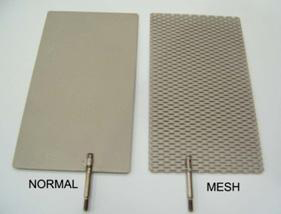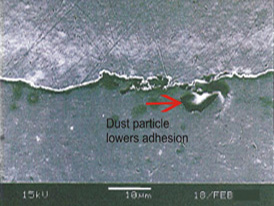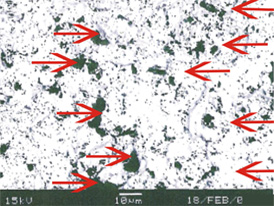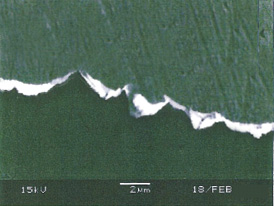
Water Ionizer Electrodes: The Heart of the Matter
We drink alkaline ionized water for the healthy properties. The electrodes create the ionization which deliver those benefits. When it comes to ionizers, understanding electrodes is like understanding the importance of your cardiac system to your overall health.
The water cell is the heart of an ionizer. It consists of a series of electrodes (plates), each separated by a membrane. This page will explain how electrode technologies differ and what that means to ionizer performance and ultimately your health.
There is so much hype and misinformation about electrodes or plates. Some say bigger plates are better. Others make you think that more plates are better. Some advertise more power – like 800 watts - as if we were powering 20-inch sub-woofers. We are ionizing water. The reality is that bigger or more plates or more power means inefficient engineering and lower quality materials and manufacturing. More or bigger DOES NOT mean better performance. An often overlooked yet incredibly important point is that more power also means more heat, which means the platinum plating breaks down faster on the surface of the electrode. This equals poor performance over time.
 Smart Shopper's Shortcut
Smart Shopper's Shortcut What you need to know about electrodes...

There is so much hype and misinformation about electrodes. You will hear bigger and / or more are better. One advertises 13 plates and 800 watts. We are ionizing water not powering 20-inch sub-woofers! Bigger or more plates or more power really means inefficient engineering, low quality materials and poor manufacturing – NOT better performance. Consider this too: more power means more heat which breaks down the platinum plating faster resulting in poor performance.
There is hype too around plate type. Performance is not about the plate type, but rather the sophistication of the engineering and the quality of the materials and manufacturing.
Educate yourself on some basics and you will easily see why our Smart Electrodes offer you the most advanced engineering, along with the best materials and manufacturing. This means more efficient performance and lasting durability. That is powerful. That is smart.
There is hype too around the type of plates. Again, performance does not come down to the type of plate, but rather the sophistication of the engineering and the quality of the materials and manufacturing.
After educating yourself on some basics, you can easily see why our Smart Electrodes offer you the most advanced engineering, along with the best materials and manufacturing. This adds up to more efficient performance and lasting durability. All things that smart shoppers look for.
Smart Electrodes
Smart Electrodes start with the highest quality materials. We use certified 99.9% pure titanium from Japan and the highest quality platinum.
The electrodes are engineered employing an advanced flat design that offers more effective surface area than slotted or mesh plates of the same size.
Then the electrodes are robotically electro-plated using a proprietary technique. A computer controlled robotic arm is used to apply the platinum, under pressure, multiple times and from different angles that allows the most precise plating application. The resulting plate surface can direct a uniform electron flow and provide the most efficient power saturation.
Our proprietary electroplating process and the resulting Smart Electrodes feature technological advances and enhanced performance characteristics which allow superior ionizer performance in the following ways:
- Superior platinum adhesion
- Superior conductivity which allows for lower power and higher efficiency
- Increased surface area; up to 3x the number of vertices as smooth dipped plates
- Optimized water flow dynamics over the plate surface due to vertices (increased performance proven in independent US EPA certified testing)
When you discover more about Electrodes, you can easily understand what puts Smart Electrodes in a league of their own.
Get your PhD in electrodes by clicking on each topic below.
Material Composition
Titanium is the base material in every ionizer electrode/plate, because it has proven safe and effective. It is corrosion resistant, has the highest strength-to-weight ratio of any metal, is very durable, and demonstrates the ability to easily change polarity, which is critically important in the ionization process. The best ionizer plates are coated with platinum because it was determined in a 1992 study by the Japanese Ministry of Health, Labor and Welfare, that platinum is the only entirely safe material to use in water ionizer plating/coating.
Electrode Types
There are three basic types of plates:
- Flat Plate: The most common, basic and simple plate design.
- Mesh Plate: The most technically advanced configuration; also the most expensive to manufacture.
- Slotted or “Hybrid” Plate: A less expensive and less effective version of mesh plate technology.
Regardless of what you read, the most critical part of an electrode is not the type but rather how the electrodes are engineered, what materials are used and how they are applied or manufactured.
Mesh or Solid Plates?

There are three, distinctly different, types of plate designs offered in the market today and each has its own advantages or disadvantages. These are solid plates, slotted or “hybrid” plates and mesh plates.
These differences have a dramatic effect on power delivery inside of the cell. All three types of plates can deliver the electrical current to the water, but why are our plates the most efficient? Easy … our highly advanced Smart Electrode Technology!
Traditional Flat Plates
A low quality flat plate has no way to organize or channel the current being delivered, meaning it has an inconsistent saturation of electrons. They move across the plate finding the path of least resistance, often channeling together and are not effectively or evenly dispersed. This is like watering a garden and having the water run to the low spots and pool there. This results in an inconsistent delivery of power and less efficient / effective ionization results.
Slotted Plates
In contrast to a flat plate, with slotted, there is a clear path for the electrons to travel in more predictable directions - effectively distributing the power in a consistent pattern. When we till our garden into rows and irrigate we are channeling the water to be delivered to the roots where it is needed most. The slotted plate is more effective than the traditional flat plate. Often has a less effective surface area, depending on the size of the slot.
Mesh Plates
A mesh plate uses the same principle as the slotted plate, but improves upon it by providing cross-channeling to more evenly direct electron flow. The applied current more evenly saturates the plate, increasing the effective delivery of electrical current to create better alteration in your water. Can have a less effective surface area depending on the design of the mesh.
Plating or Dipping
Long term research and development findings derived from a 1992 study by the Japanese Ministry of Health, Labor and Welfare indicate platinum to be the only entirely safe material for use in water ionizer plating/coating.
Two distinct methods - Plating (dipping) and Coating; are employed to apply the platinum surface to the titanium plate:
Plating: Also known as Cladding or Dipping, plating is the process by which a titanium plate is submerged in a platinum solution. This is the most commonly used manufacturing process due to its cost efficiency.
Coating: Also known as Electroplating, coating is a technically advanced process designed to achieve a higher degree of consistency and uniformity.
The two biggest differences between plating and coating are:
The amount of titanium crystals produced
The surface coverage characteristics
The following examples visually illustrate two distinct platinum application techniques, Plating (dipping) and Coating (Electroplating).
Plating or Dipping
Both dust and voids are clearly visible
Plate surface from above:Black spot represent voids |
X 6000 (Cross section):X 6000 (Cross section) |
AlkaViva Coating (Electroplating)Note the distinct vertices (peaks and valleys) and a 3-dimensional crystalline surface, as compared to the inconsistent surface of the dipped electrodes. | |
Plate surface from above:No voids, thin spots or inconsistencies |
X 6000 (Cross section):No voids, thin spots or inconsistencies |
Prevention of Titanium Leaching
AlkaViva is able to totally prevent titanium leaching on the electrodes by two methods:
Complete and uniform coverage. Our coating process surpasses all other processes in the ionization industry to more completely and evenly cover the titanium plates with pure platinum, including all edges and all surfaces.
More efficient use of power. This means we can apply less power more efficiently which creates far less heat and stress on the plate during the electrical load phases.
View a certified analytical test result from the United States Environmental Protection Agency Primacy Laboratory for the State of Nevada showing that there is no leaching.
Optimal Results Without Additives
AlkaViva employs proprietary technologies which are able to achieve optimal alkalizing and acidifying results without the use of (potentially harmful) solutions such as salt enhancers.
It isn’t ALL about Electrodes: Membranes
All ionizers employ ion-selective membranes to separate the electrodes and enable the water to “ionically separate” the water into an alkaline and acidic stream. The membrane is absolutely critical in how an ionizer performs. You can have a well-designed plate, powered optimally but if you have poor membranes, then you have poor performance. Other ionizer manufacturers buy their membranes from outside sources. In comparison, AlkaViva’s Infusion Membranes are made in-house and are ultrasonically pressed, rather than chemically bonded. This provides you with a distinctly superior membrane, designed to work specifically with our Smart Electrodes, giving you unmatched performance.
Our competitors use more watts and amps, spreading the same input voltage over a larger surface area which results in less efficiency. They do not deliver the power evenly or efficiently and must do so with greater resistance.
More power means more heat, which means the platinum plating breaks down faster on the surface of the electrode. This equals poor performance over time.
So now you can see that in truth, bigger is not better. This is why the electronics industry (and others) has shown that when technology advances, it typically results in smaller, more powerful and devices. Why would ionizers be any different? The truth is they are not.











